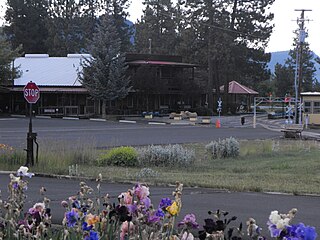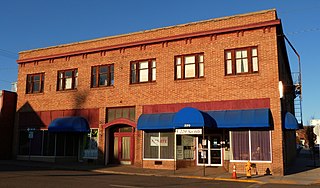
Klamath Falls is a city in, and the county seat of, Klamath County, Oregon, United States. The city was originally called Linkville when George Nurse founded the town in 1867. It was named after the Link River, on whose falls the city was sited. The name was changed to Klamath Falls in 1893. The population was 21,813 at the 2020 census. The city is on the southeastern shore of the Upper Klamath Lake.

Lakeview is a town in Lake County, Oregon, United States. The population was 2,418 at the 2020 census. It is the county seat of Lake County. The city bills itself as the "Tallest Town in Oregon" because of its elevation, 4,757 feet (1,450 m) above sea level. Lakeview is situated in the Goose Lake Valley at the foot of the Warner Mountains and at the edge of Oregon's high desert country. Its economy is based on agriculture, lumber production, and government activities. In addition, tourism is an increasingly important part of the city's economy. Oregon's Outback Scenic Byway passes through Lakeview.

Shaniko is a city located in Wasco County, Oregon, United States, on U.S. Route 97 and about 8 miles (13 km) north of Antelope. The population was 30 at the 2020 census.

Bly is an unincorporated community in Klamath County, Oregon, United States. By highway, it is about 50 miles (80 km) east of Klamath Falls. As of 2020, the population was 207.

The OC&E Woods Line State Trail is a rail trail in Klamath and Lake counties in the U.S. state of Oregon. It is Oregon's longest state park. The trail follows the old OC&E and Weyerhaeuser railroads from Klamath Falls to Thompson Reservoir. Along its 105-mile (169 km) length it passes through the communities of Olene, Sprague River, Dairy, Beatty, and Bly.

Algoma is an unincorporated community on the east shore of Upper Klamath Lake, in Klamath County, Oregon, United States. It is about 8 miles (13 km) north of the city of Klamath Falls on U.S. Route 97. Algoma was named for the Algoma Lumber Company.

The Nevada–California–Oregon Railway was a 3 ft narrow gauge railroad originally planned to connect Reno, Nevada, to the Columbia River. However, only 238 mi (383 km) of track were laid so service never extended beyond Lakeview, Oregon. Because of the company’s reputation for mismanagement, it was often called the "Narrow, Crooked & Ornery" railroad.

Collier Memorial State Park is a state park in southern Oregon. The park is operated and maintained by the Oregon Parks and Recreation Department. It is located on U.S. Highway 97, approximately 30 miles (48 km) north of Klamath Falls and 105 miles (169 km) south of Bend. The park covers 146 acres (59 ha) along the Williamson River.

The Balch Hotel is a historic commercial lodging building in Dufur, Oregon, United States. It was built in 1907 by Charles Balch, a local land owner and businessman. The hotel has changed hands a number of times over the years, but it has remained in continuous use since it was constructed. Today, the Balch Hotel is an active hotel serving visitors to the Dufur area. Because of its importance to local history, the Balch Hotel is listed on the National Register of Historic Places.
The Simpson Investment Company is a privately held holding company based in Seattle, Washington in the US Pacific Northwest that specializes in manufacture of forest products. Founded as a logging company in 1890 by Sol Simpson, the company is now owned by the Reed family.

The Pengra Pass rail route, also known as the Natron Cutoff, the Cascade Subdivision, or the Cascade Line, is a Union Pacific Railroad line connecting Eugene, Oregon, with Klamath Falls, Oregon. Construction of the line began in 1905 and was completed in the mid-1920s. Its name denotes a mountain pass on the Lane County–Klamath County boundary in the Cascade Mountains of Oregon, about 1.5 miles (2.4 km) from Willamette Pass. The line heads southeast from Eugene, up the Cascades and over Pengra Pass, then southward beside U.S. Route 97 to Klamath Falls, where it splits in two, each track continuing into California. The route has at least 22 tunnels, several snow sheds and multiple bridges across canyons. BNSF has trackage rights between Klamath Falls and Chemult.

Rocky Point is an unincorporated community in Klamath County, Oregon, United States. It is on Pelican Bay on the west shore of Upper Klamath Lake, about 29 miles (47 km) northwest of Klamath Falls and about 3 miles (5 km) north of Oregon Route 140 on Forest Highway 34. It is within the Winema National Forest.

Train Mountain Railroad is the world's largest miniature hobbyist railroad near Chiloquin, Oregon, in Klamath County, which is in the south central region of Oregon. It is situated between Klamath Falls, Oregon, approximately 26 miles (42 km) to the south, and Crater Lake National Park to the north. Physical Location: 36941 South Chiloquin Road, Chiloquin, OR 97624, USA.
Ady is an unincorporated historic locale in Klamath County, Oregon, United States.

The Bisbee Hotel is a hotel building in Klamath Falls, Oregon, in the United States. It was built in 1926 and added to the National Register of Historic Places on October 12, 2006.

Klamath was the first and only vessel larger than a launch to operate on Lower Klamath Lake, which straddled the border between the U.S. states of Oregon and California. This vessel is chiefly known for having been hauled overland by rail from Lake Ewauna to Upper Klamath Lake. It was also one of only two licensed merchant vessels ever to operate on lower Klamath Lake. During 1905 to 1909, Klamath was an essential link in a transportation line to Klamath Falls which involved rail, stage coach, and steamer travel. The late arrival of railroads to the Klamath lakes region made riverine and lake transport more important to the area.

















